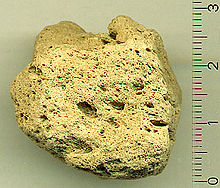
Back خفاف Arabic Пемза Byelorussian Пемза Bulgarian ঝামা পাথর Bengali/Bangla Pumicita Catalan Pemza Czech Pwmis Welsh Pimpsten Danish Bims German Κίσσηρη Greek


Pumice ( /ˈpʌmɪs/), called pumicite in its powdered or dust form, is a volcanic rock that consists of extremely vesicular rough-textured volcanic glass, which may or may not contain crystals. It is typically light-colored. Scoria is another vesicular volcanic rock that differs from pumice in having larger vesicles, thicker vesicle walls, and being dark colored and denser.[1][2]
Pumice is created when super-heated, highly pressurized rock is rapidly ejected from a volcano. The unusual foamy configuration of pumice happens because of simultaneous rapid cooling and rapid depressurization. The depressurization creates bubbles by lowering the solubility of gases (including water and CO2) that are dissolved in the lava, causing the gases to rapidly exsolve (like the bubbles of CO2 that appear when a carbonated drink is opened). The simultaneous cooling and depressurization freeze the bubbles in a matrix. Eruptions under water are rapidly cooled and the large volume of pumice created can be a shipping hazard for cargo ships.[3]
- ^ Jackson, J.A., J. Mehl, and K. Neuendorf (2005) Glossary of Geology American Geological Institute, Alexandria, Virginia. 800 pp. ISBN 0-922152-76-4
- ^ McPhie, J., M. Doyle, and R. Allen (1993) Volcanic Textures A guide to the interpretation of textures in volcanic rocks Centre for Ore Deposit and Exploration Studies, University of Tasmania, Hobart, Tasmania..198 pp. ISBN 9780859015226
- ^ Redfern, Simon. "Underwater volcano creates huge floating islands of rock, disrupts shipping". Phys.org. Omicron Technology Ltd. Retrieved 25 April 2014.